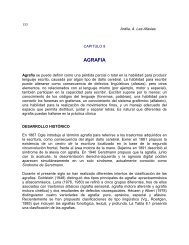the PDF of her book - National Aphasia Association
the PDF of her book - National Aphasia Association
the PDF of her book - National Aphasia Association
You also want an ePaper? Increase the reach of your titles
YUMPU automatically turns print PDFs into web optimized ePapers that Google loves.
46 Ruth Codier Resch Without Utterance:<br />
My Parsons flower drawing teac<strong>her</strong>, after many semesters<br />
with <strong>her</strong>, is leaving teaching. Like me, she is balancing <strong>her</strong> life<br />
and work with a disability, multiple sclerosis. She is leaving to<br />
concentrate on <strong>her</strong> textile design work. When I ask for a reference,<br />
she sends me to <strong>her</strong> own painting teac<strong>her</strong>.<br />
Henry Pearson, a well-known painter, nei<strong>the</strong>r shows his work or anyone<br />
else’s when he teaches. He quietly persists in our finding our own style. In<br />
<strong>the</strong> first class he talks practicals about materials, and that’s <strong>the</strong> end <strong>of</strong> class<br />
teaching.<br />
Instead he sits down with every one <strong>of</strong> us individually during <strong>the</strong> class,<br />
talks about poetry, movies, what I am doing or what I want to do, in my<br />
life or in my painting. If I want him to give me technical instruction, he will<br />
give only what I ask for. He creates an atmosp<strong>her</strong>e <strong>of</strong> ease and expression,<br />
wandering in personal experiment—seeing in <strong>the</strong> mind. Some students are<br />
painting in oils and o<strong>the</strong>rs in watercolor. Some are doing collage, and still<br />
o<strong>the</strong>rs are sculpting, though <strong>the</strong> class is titled “Abstract Watercolor.”<br />
I don’t know what I want to do, let alone how to experiment. Most <strong>of</strong><br />
<strong>the</strong> new people drop out by <strong>the</strong> third week. The rest are old-timers, some <strong>of</strong><br />
many years. I stay, not knowing why.<br />
Without class assignments, I bring my vase <strong>of</strong> flowers. I am comfortable<br />
<strong>her</strong>e, <strong>the</strong> students companionable. The three women at my table work in<br />
totally different styles, and it’s a lesson just watching how <strong>the</strong>y work. One<br />
is a ma<strong>the</strong>matics teac<strong>her</strong> and works with webs <strong>of</strong> grids. Ano<strong>the</strong>r paints in<br />
geometric spirals on a small canvas, changing <strong>the</strong> colors in small spaces each<br />
time she goes around. Though I am intimidated, it is <strong>the</strong> right place to be.<br />
Henry has an ability to see beyond what I am doing. He <strong>of</strong>fers visions<br />
to tweak my imagination. One day in my second year with him, he lends me<br />
a <strong>book</strong> <strong>of</strong> Japanese paintings.<br />
“Here, Ruth, look at <strong>the</strong>se. Find <strong>the</strong> work that is like yours.”<br />
I take <strong>the</strong> <strong>book</strong> home, delight in <strong>the</strong> misty, <strong>the</strong> spare, <strong>the</strong> ornate. The



